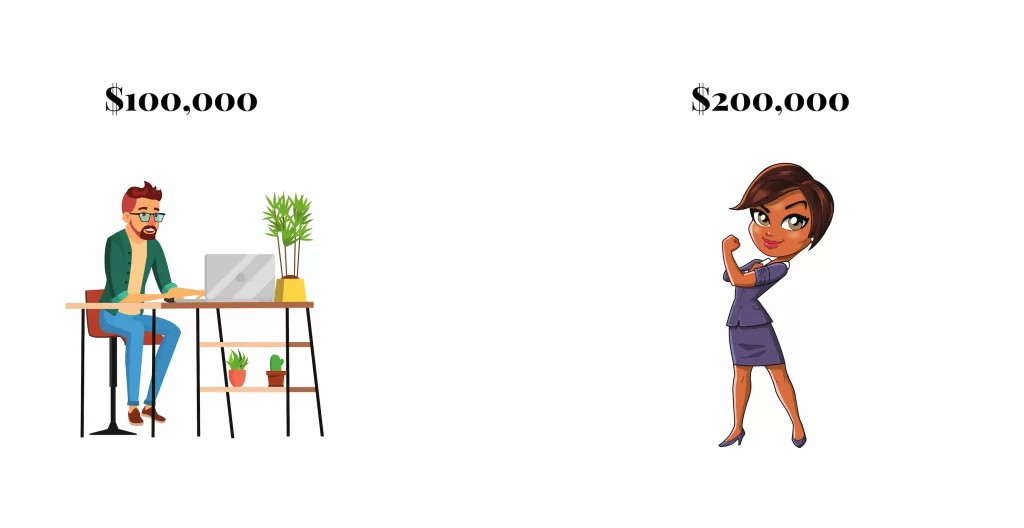Introduction
If you are serious about building your wealth you need to have a basic understanding of how the Canadian tax system works. The top tax rate in Ontario is 53.53% in 2022. If you don’t plan properly, you can lose a lot of your hard-earned wealth to taxes. This article will give you the basics of personal taxes and get you on your way to saving taxes and building wealth.
All small business owners will need to pay personal taxes. As a small business owner, you likely started your business by earning most, if not all, your income as a sole proprietor. If you carry on your business through a corporation, you will draw money from the corporation and may need to pay personal tax. This article will help you understand how personal taxes work and give you tips to lower your taxes and have a pain-free tax season.
Who are Individuals from a Tax Standpoint?

- Individuals are people like you and me.
- Individuals are taxed differently from Corporations and Trusts, so that’s why we make the distinctions.
- Usually individuals are taxed higher than corporations.
Who has to pay tax in Canada?

- All Canadian tax residents are liable to pay tax in Canada on their worldwide income.
- So if you are a Canadian resident and earn income from outside of Canada, such as consulting gigs, you will be taxed on that foreign income in Canada.
- International tax is complicated, and countries have tax treaties to avoid double taxation, so it is best to seek a tax specialists who deal with this stuff everyday like LRK Tax. Otherwise, you may be leaving money on the table.
Who is a resident of Canada for tax?
- The government uses primary and secondary ties to see if you are a resident of Canada.
- People may be residents of two countries. If so, you will need to analyze the tax treaties (beyond the scope of this webinar).
- If you have ties in two or more countries, best to seek a tax specialist.
| Primary residential ties | Secondary residential ties |
|
|
How are Individuals Taxed?

- Individuals are taxed based on progressive tax rates.
- What does this mean? Progressive taxation means the higher the income, the higher your taxes. This is the opposite of a flat tax, whereby everyone pays taxes at the same tax rate regardless of how much they earn.
- Think of it like climbing a hill. The higher you climb up on your earnings, the higher the taxes you pay. The person at the top of the hill (higher tax bracket) will pay more tax than a person at the bottom of the hill (lower tax bracket).
Example – Progressive Tax

- For example, suppose Bob earns $100,000 while Mary earns $200,000.
- In Ontario, using 2021 tax rates, Bob will pay approx. $24,000 (or 24%) in taxes, while Mary will pay around $70,000 (or 35%).
- In Ontario, the tax bracket looks like the following:
| Combined Federal & Ontario Tax Brackets and Tax Rates Including Surtaxes | |||||
| 2022 Taxable Income | Ontario 2022 Marginal Tax Rates | ||||
| Ordinary Income (employment, business, rent, interest, foreign) | Capital Gains | Canadian Dividends | |||
| Eligible (Public Companies) |
Non-Eligible (Private Companies) |
||||
| first $46,226 | 20.05% | 10.03% | -6.86% | 9.24% | |
| over $46,226 up to $50,197 | 24.15% | 12.08% | -1.20% | 13.95% | |
| over $50,197 up to $81,411 | 29.65% | 14.83% | 6.39% | 20.28% | |
| over $81,411 up to $92,454 | 31.48% | 15.74% | 8.92% | 22.38% | |
| over $92,454 up to $95,906 | 33.89% | 16.95% | 12.24% | 25.16% | |
| over $95,906 up to $100,392 | 37.91% | 18.95% | 17.79% | 29.78% | |
| over $100,392 up to $150,000 | 43.41% | 21.70% | 25.38% | 36.10% | |
| over $150,000 up to $155,625 | 44.97% | 22.48% | 27.53% | 37.90% | |
| over $155,625 up to $220,000 | 48.35% | 24.17% | 32.19% | 41.79% | |
| over $220,000 up to $221,708 | 49.91% | 24.95% | 34.34% | 43.58% | |
| over $221,708 | 53.53% | 26.76% | 39.34% | 47.74% | |
[Source: Tax Tips]
How are Corporations Taxed?

- Corporations are separate legal entities from their owners (they are a separate person for tax and legal purposes)
- Corporations are taxed at a flat rate
- Very generally, the first $500,000 of business income (including medical earnings) gets taxed at 12.2% in Ontario (in 2022).
- When the corporation pays out a salary or dividends to its shareholders (i.e., the owner), the individual owner will pay additional taxes on the dividends so they will be in the same position as if they earned the income directly.
- But, you may not need all your income. You may be able to defer paying the personal tax into the future and invest the rest in the corporation.
Different Types of Income Taxed at Different Rates
What are the different types of income?
Below are some of the most common types of income that individuals earn. Some of these incomes are reported on tax slips you receive annually (around tax time). Others, you need to compute yourself.
| Income Type | Description | Tax Slip |
| Wages & Salaries |
|
|
| Business (Sole-Proprietor) |
|
|
| Interest |
|
|
| Dividends |
|
|
| Rental |
|
|
| Capital gain |
|
|
Note how different types of income get taxed at different rates.
- Ordinary income includes employment income, income from your business as a sole proprietor, interest, rent, RRSP withdrawals, pension, royalties, and foreign income.
- Capital gains are taxed at 50% of ordinary income rates. So all else equal, generally, it is preferable to earn capital gains compared to other sources of income.
- Note how the government taxes Canadian dividends at a lower rate than ordinary income. We understand why this is when we recognize what dividends are. Dividends are after-tax money that a corporation pays to its shareholders. Since the corporation has already paid taxes on its income, the individual shareholder who receives the dividends gets a dividend tax credit for the corporation’s taxes. This makes the overall tax rate on dividends lower for the individual. This is why some of the rates on the table above are negative: This simply means the corporation paid taxes at a rate higher than the individual’s marginal tax rate.
Suppose, you were presented with an investment opportunity to earn a 10% return as capital gains vs. interest, all else equal, you would opt for the capital gains. You know now that different types of income are taxed at different taxed rates. This knowledge should allow you to have nuanced discussions with your financial advisors because the taxes add up over time!
The Most Common Tax Deductions
Deductions reduce your taxable income, thus reducing your taxes. As a small business owner, make sure you understand some of the deductions available to you.
| Deduction | Description |
| RRSP Contributions |
|
| Union/Professional dues |
|
| Childcare expenses |
|
| Moving Expenses |
|
| Business Expenses |
|
| Home Office Expenses |
|
Good Resources to Quickly Estimate Your Taxes
The team over at Wealthsimple has built a great calculator that you can use to estimate how much taxes you will owe. Click here to access the calculator.

Personal Tax Deadlines

- The tax filing due date is April 30th for most taxpayers.
- If you or your spouse or common-law partner carried on a business, your return must be filed by June 15, 2021. However, if you have a balance owing, you must pay it on or before April 30, 2021.
- So even if you and/or your spouse carried on a business (i.e., self-employed), you still need to pay your taxes by April 30th, but you have until June 15th to file your tax return. The government gives business owners a bit longer to file their taxes because they need to gather more documents and do more calculations to calculate their income. So what people usually do is to estimate their taxes for the April 30th deadline and then top it up by June 15th, with interest.
- Our suggestion is not to wait. Save on the additional interest. We can help you put together your business income at lightning speed using the latest cloud accounting apps.
Tax Instalments

Tax instalments and planning for them is something that trips up new business owners. Often, we noticed that new business owners do not plan properly for tax instalments and end up dipping into their line of credits. We fix this by giving our small business clients a tax budget they can easily complete in a matter of minutes to map out their tax payments for the year. This avoids surprises. Here’s what you need to know about tax instalments:
- Some individuals need to pay their current year’s taxes in quarterly instalments: March 15th, June 15th, September 15th, and December 15th
- Suppose your primary sources of income are wages and salary. In that case, you generally do not have to pay instalments because your employers may be remitting and withholding tax every month.
- If you have other sources of income (business income, dividends, or capital gains), you may need to pay taxes in quarterly instalments
- You need to pay next year’s taxes (i.e., 2022) in instalments if the difference between the total tax in the current year (i.e., 2021) exceeds the amount of taxes withheld at source by $3,000, then. In other words, if you had a balance owing on your 2021 tax return of more than $3,000, you will need to start estimating and paying your 2022 taxes in quarterly instalments.
- This could cause a huge cash crunch around March/April time if you don’t plan ahead!
- Your accountant will be able to let you know if you have to pay your taxes in quarterly instalments. CRA will also send you instalment reminders. But the number CRA calculates may be higher than what you actually need to pay.
- Another point is when a business owner transitions from a sole-propreitor to practicing through a corporation, they may not need to pay instalments if they take salary from the corporation since taxes would be withheld and remitted to CRA on your payroll.
Late Filing Penalties

- If you file your tax return late, there may be a penalty.
- The penalty is generally the balance of tax owing x 5% + 1% for each complete month late up to a maximum of 17%.
Pro Tips to Avoid a Dreadful Tax Season

One of the most important tips we give our clients is to open up a separate bank account and a credit card for your sole proprietor business. This makes bookkeeping a breeze and avoids a painful and dreaded tax season.
How to Pay Taxes to CRA?
You can make a payment online, in person, or by mail. You can learn more about it here.
Online is Most Common Way to Pay CRA
Most people tend to pay using online banking. These are the instructions:
- Sign in to your financial institution’s online banking service for individuals.
- Under “Add a payee,” look for an option such as CRA (revenue) – current-year tax return
- Use this option to make a payment for your current tax return. You can use this option only once per return.
- CRA (revenue) – tax amount owing – Use this option to pay any amount due.
- CRA (revenue) – tax instalment – Use this option to make payments toward the future tax year.
- Enter your 9-digit social insurance number as your CRA account number.
- Ensure the number is accurate so that the CRA can apply your payment correctly.
Third-Party Providers
Suppose you want to pay using a credit card. In that case, you need to use a third-party service provider like PaySimply or Plastiq (these are the two suggested on CRA’s website). These providers offer payment by credit card, debit card, PayPal, or Interac e-Transfer. They charge a fee (1% to 2.5%) for their services. The third-party service provider will send your individual or business payment and remittance details online to the Canada Revenue Agency (CRA) for you.
Key Takeaways
We covered a lot of material, but here are some of the critical takeaways we would like you to grasp:
- Individuals are taxed using progressive tax rates: Higher the income, the higher the tax rate.
- Different types of income are taxed at different tax rates. This should allow you to plan your investment startegies with tax in mind. For example, you now know that capital gains are taxed at a lower rate than other sources of income.
- Corporations are taxed at a flat rate. The first $500,000 of business income in a Corporation generally gets taxed at 12.2% in Ontario (in 2022). This why many small business owners set up a corporation. This allows them to defer the personal taxes into the future and build up their investment wealth inside the corporation.
- Deductions can reduce taxes, and you should be familiar with some of the common deductions. If you haven’t already, you should sign up to receive our excel templates to avoid missing out on any standard deductions.